Star trek is quickly becoming a fact by 3d printing
-
Star trek is quickly becoming a fact by 3d printing
- Replicator
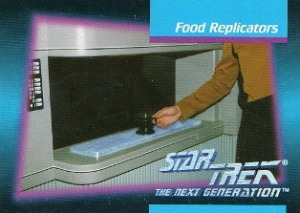
Replicator (Star Trek) - Wikipedia, the free encyclopedia | en.wikipedia.org
"Although previous sci-fi writers had speculated about the development of "replicating" or "duplicating" technology,[1] the term "replicator" was not itself used until Star Trek: The Next Generation. In simple terms, it was described as a 24th century advancement from the 23rd century "food synthesizer" seen in Star Trek: The Original Series. The mechanics of these devices were never clearly explained on that show, but the subsequent prequel series, Star Trek: Enterprise, featured a 22nd-century version referred to as a "protein resequencer." Additionally, that ship had a "bio-matter resequencer" which was used to recycle waste product into usable material.[2]"
" A replicator can create any inanimate matter, as long as the desired molecular structure is on file, but it cannot create antimatter, dilithium, latinum, or a living organism of any kind; in the case of living organisms, non-canon works such as the Star Trek: the Next Generation Technical Manual state that, though the replicators use a form of transporter technology, it's at such a low resolution that creating living tissue is a physical impossibility."3D printers make Star Trek food replicators a reality | gmanetwork.com
"On the original Star Trek TV series from the 1960s, they had their fictional replicator technology that materialized food, drink and non-edible objects. Well…now 3D printing is turning fiction into fact. There’s even a 3D printer by MakerBot Industries called the Replicator. Okay, we’re not quite at the Star Trek level yet, but the number of objects we can “print” is quickly growing, and the list includes useful things such as human organs, limbs and even synthetic food including pizza. Chefs probably don’t have to worry about their jobs just yet, as some of this 3D-printed food so far is intended for consumption by astronauts in space — where 30 minutes or free for pizza obviously isn’t an option. As well, 3D printing is in its infancy. In the near future, though, you could very well order something online and have it created in front of you from a home or office 3D printer — not unlike the Star Trek replicator."Foodini 3D Printer Cooks Up Meals Like the Star Trek Food | inhabitat.com
"Foodini helps create savory or sweet cuisine. The food is real food, made from fresh ingredients prepared before printing. Promoting cooking with fresh ingredients, Foodini manages the difficult and time-consuming parts of food preparation that often discourage people from creating homemade food."How 3D food printers will revolutionize cooking | The Week Magazine
"The Foodini bills itself as "the first 3D printer to print all types of real, fresh, nutritious foods, from savory to sweet" — like ravioli, quiches, and even pizza — into any shape you can sculpt on a computer. It also has a scanner that can scan any object and either print decorations on top of it or print a food in that object's exact shape."Will 3D food printers catch on with America's home cooks? | Fox News
Foodini,

Man Creates Food With 3D Printer - The Foodini | InformOverload·1,272 videos
http://www.youtube.com/watch?v=DfzcnmDZHzo3D Printing technology : One Step Closer to a Star Trek Future? ( The begaining - stag 1 - macro level ) - Dukejazz
"Star trek is quickly becoming a fact by 3d printing. It not a true atomize copy, but is a VR model to a material bonded copy." -
Star trek is quickly becoming a fact by 3d printing
- Transporter
Transporter (Star Trek) - Wikipedia, the free encyclopedia | en.wikipedia.org
"A transporter is a fictional teleportation machine used in the Star Trek universe. Transporters convert a person or object into an energy pattern (a process called dematerialization), then "beam" it to a target, where it is reconverted into matter (rematerialization). The term transporter accident is a catch-all term for when a person or object does not rematerialize correctly"
Could 'Star Trek' technology ever become reality? | scpr.org_Transporter
"How about "beaming up," known as dematerialization and rematerialization?"
"That's a pretty tough one. I was hanging out with some science fiction writers yesterday, and there's even debate amongst ourselves about what's actually happening. Are we taking an image of the exact state of the human being, destroying them, and just taking the information like a fax and sending it down somewhere else and somebody rebuilds the person with that information, or are we actually taking the energy that comes from taking their matter and turning it into energy, and beaming that down?"
" It is way out there, ... transporter technology. We are getting to the place where we think we can build 3-D things with 3-D printers, but the idea of being able to capture someone's self, even their thoughts, and transport through space and then rematerialize"Ok lets think a bit. We can scan shape to VR cad maxro-ly and send it to any 3d printer
thus a stage 1 VR macro transporter with a bi-product source. And guess what, NASA is building this stage one device now for a next mars man mision.-dukejazzTea, Earl Grey, Hot”… How Scientists Replicated a Mars Meteorite | Universe Today
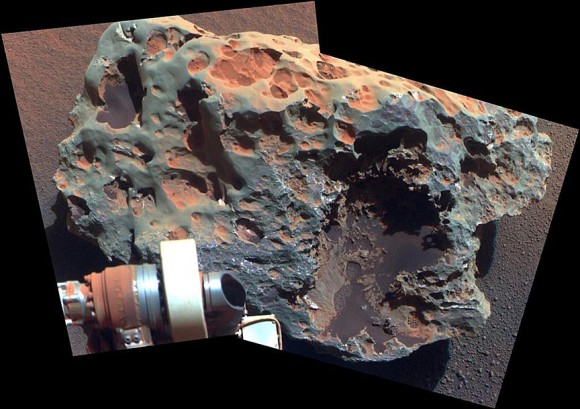
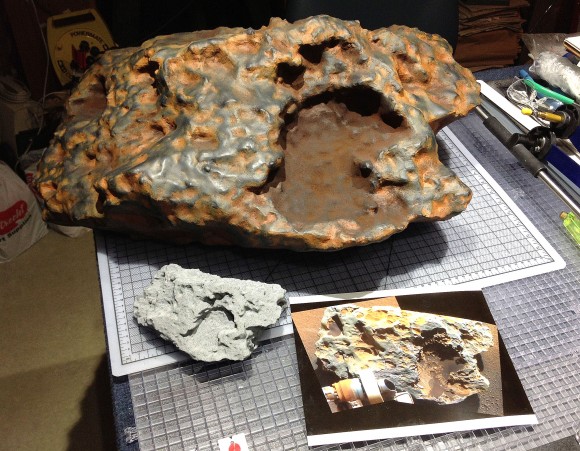
"Measuring about two feet (60 cm) across, it’s about the size of picnic cooler and weighs an estimated 1,000 pounds. The replica’s made of plastic – you could tote it around like a … picnic cooler.
Analysis of Block Island’s composition using the rover’s alpha particle X-ray spectrometer confirmed that it’s rich in iron and nickel. Scientists based the design of the plastic meteorite on detailed measurements and stereo images taken by Opportunity’s panoramic camera."Here is new system that is both a Replicator and Transporter
This 3D Printer is Basically Star Trek's Replicator and Transporter Rolled Into One Machine | Tom Pritchard
3D printing is pretty futuristic technology, and is currently the closest thing we have to the replicators made famous by Star Trek. Well, the Zeus takes 3D printing not one, but two steps further. It's a 3D printer that has a built in 3D scanner which lets you "fax" items elsewhere.
"Star trek is quickly becoming a fact by 3d printing. It not a true atomize copy moved , but is a VR model to a material bonded copy that can be faxed." (like a star gate)
-
- Warp speed:
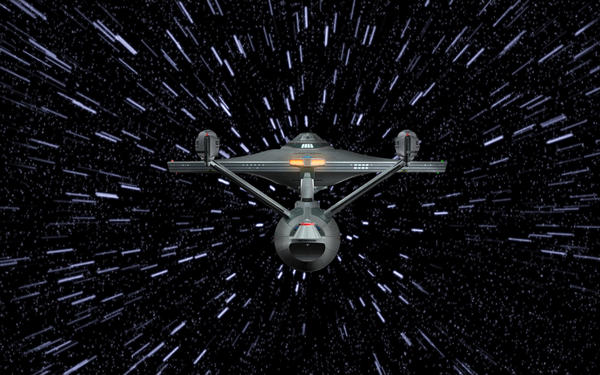
Warp drive | From Wikipedia, the free encyclopedia
( Highlight web title, right click, click search engine and then goto web site )
"Warp drive is a hypothetical faster-than-light (FTL) propulsion system in many works, most notably Star Trek. A spacecraft equipped with a warp drive may travel at apparent speeds greater than that of light by many orders of magnitude, while circumventing the relativistic problem of time dilation. In contrast to many other FTL technologies, such as a jump drive or the Infinite Improbability Drive, the warp drive does not permit instantaneous travel between two points; instead, warp drive technology creates an artificial "bubble" of normal space-time which surrounds the spacecraft (as opposed to entering a separate realm or dimension like hyperspace, as is used in the Star Wars, Stargate Warhammer 40,000, Babylon 5, Cowboy Bebop, and Andromeda franchises)."
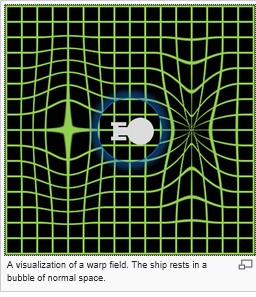
Could 'Star Trek' technology ever become reality? | scpr.org_Transporter
"What is warp speed and how possible is it?"
"Warp Speed is a cousin of physics that we think we understand. Nothing in our universe can move faster than the speed of light as long as it stays in the dimensions that we're aware of. Warp Speed is sort of our way of cheating through that. The idea in 'Star Trek' is that you surround a bubble around the spacecraft that keeps it in 'sub-warp space,' and then you move that bubble through space time by warping space time and allow yourself to move faster than the speed of light. That's something that we don't understand how to do now, but in some ways it's possible to imagine us learning physics that would teach us how to wrap space time and move through space time faster than the speed of light."Ideas Based On What We’d Like To Achieve | ideachev.html
http://www.nasa.gov/centers/glenn/technology/warp/ideachev.html%(#008000)['The following section has a brief description of some ideas that have been suggested over the years for interstellar travel, ideas based on the sciences that do exist today.
•Worm Hole transportation
"To use an analogy: even if there were a speed limit to how fast a pencil could move across a piece of paper, the motion or changes to the paper is a separate issue. In the case of the wormhole, a shortcut is made by warping space (folding the paper) to connect two points that used to be separated. These theories are too new to have either been discounted or proven viable. And, yes, wormholes do invite the old time travel paradox problems again."•Alcubierre’s "Warp Drive"
"Yes... First, to create this effect, you’ll need a ring of negative energy wrapped around the ship, and lots of it too. It is still debated in physics whether negative energy can exist. Classical physics tends toward a "no," while quantum physics leans to a "maybe, yes." Second, you’ll need a way to control this effect to turn it on and off at will. This will be especially tricky since this warp effect is a separate effect from the ship. Third, all this assumes that this whole "warp" would indeed move faster than the speed of light. This is a big unknown. And fourth, if all the previous issues weren’t tough enough, these concepts evoke the same time-travel paradoxes as the wormhole concepts."•Negative mass propulsion
"It has been shown that is theoretically possible to create a continuously propulsive effect by the juxtaposition of negative and positive mass and that such a scheme does not violate conservation of momentum or energy. A crucial assumption to the success of this concept is that negative mass has negative inertia. Their combined interactions result in a sustained acceleration of both masses in the same direction. This concept dates back to at least 1957 with an analysis of the properties of hypothetical negative mass by Bondi, and has been revisited in the context of propulsion by Winterberg and Forward in the 1980’s."•Millis’s hypothetical "Space Drives"
"A "space drive" can be defined as an idealized form of propulsion where the fundamental properties of matter and spacetime are used to create propulsive forces anywhere in space without having to carry and expel a reaction mass. Such an achievement would revolutionize space travel as it would circumvent the need for propellant. A variety of hypothetical space drives were created and analyzed by Millis to identify the specific problems that have to be solved to make such schemes plausible."
']"One of the consequences of this Special Relativity is the light speed barrier. Here’s another way to look at it. To move faster, you add energy. But when you get going near the speed of light, the amount of energy you need to go faster balloons to infinity! To move a mass at the speed of light would take infinite energy. It appears that there is a distinct barrier here."
So here we are
'"Warp Drives", "Hyperspace Drives", or any other term for Faster-than-light travel is at the level of speculation, with some facets edging into the realm of science. We are at the point where we know what we do know and know what we don’t, but do not know for sure if faster than light travel is possible'
-
In the news today
Turning Light Into Matter May Soon Be Possible, Physicists Say | LiveScience

"As Einstein's famous equation E=mc2 proved, mass can get converted into energy and vice versa. For instance, when an electron meets its antimatter counterpart, a positron, they annihilate each other, releasing photons, the particles making up light."
"Investigators NOW would fire the beam of gamma rays from the first stage of the experiment into one end of the hohlraum right through its center. The light from both sources would smash together in this "photon-photon collider" and generate electrons and positrons. These newly made particles would not scatter off in motley directions as they would with a two-beam approach — instead, they'd zip out the other end of the hohlraum in a beam, "making them much easier to detect," Pike said."
"As our scheme can be implemented straightforwardly at various laser facilities, we are hopeful that this will happen very soon," Pike said. "Further into the future, it may possible to create other particles with this kind of photon collider, but we will have to wait for lasers to be more powerful first."
-
This was posted in the news today
Go's along on what's is in this trend on Star trek is quickly becoming a fact.How Today's Technology Is Rapidly Catching Up to Star Trek | Vivek Wadhwa
http://www.huffingtonpost.com/vivek-wadhwa/how-todays-technology-is-_b_5549042.html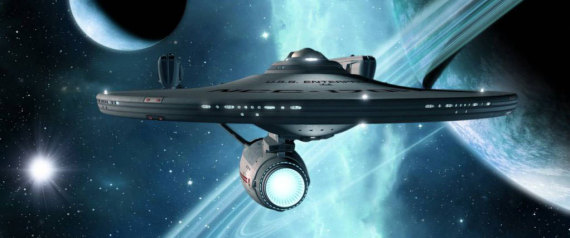
"This science fiction is, however, becoming science reality. Many of the technologies that we saw in Star Trek are beginning to materialize, and ours may actually be better than Starfleet's. Best of all, we won't have to wait 300 years."
How today’s technology is rapidly catching up to Star Trek | By Vivek WadhwaJuly 1
%(#008000)["The most exciting Star Trek marvel of all — the Starship Enterprise — may also be on its way.In discussion at Fox Studios in March 2012, Elon Musk told me that he planned to retire on Mars. He said he was inspired by Star Trek and planned to build a spacecraft like the Starship Enterprise to take him there. I really thought he was joking — or had had too much to drink. But after that, his company Space Exploration Technologies Corp., or SpaceX, successfully docked a spacecraft it had built, called the Dragon, with the International Space Station and returned with cargo. On Dec. 3, 2013, SpaceX launched a commercial geostationary satellite using Falcon rockets. SpaceX says it is planning a Dragon/Falcon 9 flight in 2015, which will have a fully certified, human-rated, escape system useable during launch.
I’ll bet that Musk does develop a version 1 of the Enterprise. And he may well be our first real-life Captain Kirk."]
-
Zefram Cochrane
Zefram Cochrane - Wikipedia, the free encyclopedia | From Wikipedia, the free encyclopedia
http://en.wikipedia.org/wiki/Zefram_Cochrane%(#008000)["Zefram Cochrane as portrayed by James Cromwell in Star Trek: First Contact

Species Human
Zefram Cochrane is a fictional character in the Star Trek universe. Created by writer Gene L. Coon, the character first appeared in the 1967 Star Trek episode "Metamorphosis", in which he was played by Glenn Corbett. James Cromwell later played Cochrane in the 1996 feature film Star Trek: First Contact and the 2001 Star Trek: Enterprise pilot, "Broken Bow". Footage of Cromwell from Star Trek: First Contact was used in the Enterprise episode "In a Mirror, Darkly (Part I)", along with new footage of an identically-dressed actor whose face is not shown.As established by the events of Star Trek: First Contact, Cochrane is the first human to create a warp drive system, and in 2063, his successful light-speed flight draws the attention of the Vulcans, leading to humanity's first official contact with an alien race
Fictional character biography[edit]
Cochrane was born in 2030, according to Star Trek: First Contact (though the novelization of that film gives his year of birth as 2013). He constructed humanity's first warp-capable vessel, the Phoenix, in Bozeman, Montana, out of an old Titan II nuclear missile.[1][2] He started the project for financial gain, and found the accounts of his future accolades as told by the crew of the Enterprise-E from the future deeply disturbing.[1][3]
On April 5, 2063, Cochrane made Earth's first warp flight, playing Steppenwolf's "Magic Carpet Ride" during blast-off. The Phoenix's warp flight is detected by a Vulcan survey ship, the T'Plana Hath, which then makes peaceful first contact with humans, including Cochrane, at the Phoenix's launch site.[1]
"]
Hi.
My online name is dukejazz but my real name is James CochranJames Cochran: My Therory: on the "Warp Drive"
WIP
-
3-D Printing "Star Trek Tech"
( Highlight web title, right click, click search engine and then goto web site )3-D Printing "Star Trek Tech" Heads to the Stars fool.com |fool.com Article Preview
"studied the companies' financials and considered the advantages of additive manufacturing over traditional manufacturing methods... only to have your well-thought-out investment thesis reduced to jokes "
-
On 4/7/2015
The Current:3D Printing Trade Shows, Announcements and Upcoming Events
3D Printed RC Car & Other Cars, Boats, or Rockets
New 3D Printer Stores, Retails, Farms, Funds & Jobs
3D Printing engineers scientist mathematician physicist
3D Printing Architecture Building, Structures, Houses & Morewill be moved and merged with,
Current news on 3d Printing 2015
in a sub page section;
PLEASE GO OR CLICK HERE.
http://sketchucation.com/forums/viewtopic.php?f=388%26amp;t=60582%26amp;start=0
for new postings.Star trek is quickly becoming a real fact by 3d printing; Warp Drives Proof;
By James Cochran; page 1:- Warp speed:
So here we are
'"Warp Drives", "Hyperspace Drives", or any other term for Faster-than-light travel is at the level of speculation, with some facets edging into the realm of science. We are at the point where we know what we do know and know what we don’t, but do not know for sure if faster than light travel is possible'
I say Hyperspace travel can be done by two warp engine mounted simular to that of the star trek interprise.
Now is light travel possible? -if I say no, we can stop right now, but if say yes than I must prove it.
Frist my hypothesis statement that you can traveling faster than speed of light.
Second hypothesis statement is my proof that I can prove it with elementry mathematics, with simple primitive geometry of space and with matter/energy of modern physicis.
see page 2 next week
Advertisement







